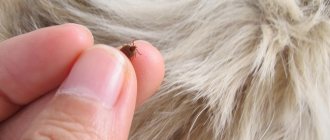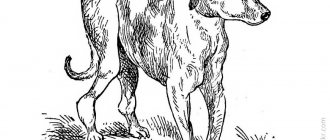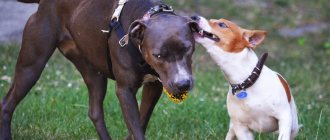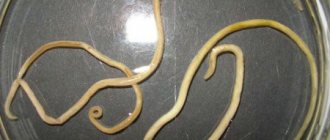Infection with worms cannot be prevented; their eggs enter the dog’s body through food, water, contact with infected animals and objects, and flea and tick bites. Helminthiasis is diagnosed both in adult animals and in puppies that do not leave the apartment. Parasite eggs are carried by their owners on the soles of shoes and on their hands, and by other animals. Helminthiasis is a dangerous disease. It leads to a deterioration in the dog’s health and appearance, and in some cases can cause death, especially in puppies. Some types of worms are also dangerous to humans. The only effective way to protect pets and people living near them is prevention. It is necessary to regularly deworm the animal, giving anthelmintic drugs recommended by the veterinarian, and also observe the rules of personal hygiene, wash your hands after interacting with animals.
Helminths in dogs: symptoms and treatment
Worm infestation in dogs is widespread and, in fact, there is no individual in whom one or another type of parasite in dogs cannot be identified. With timely prevention (deworming), this can be considered a “trouble,” although there are species that cause serious damage to the pet’s health and can be dangerous to humans.
Types of Pet Parasites
Dogs' skin can harbor parasitic insects, mites, and even helminths. The most common parasitic insect found on the skin of dogs is fleas. These are small, mobile parasites up to 4 mm in size that can be seen with the naked eye. Although fleas live on dogs and cats, their eggs, larvae and pupae are found in the environment, such as dust or carpet. Fleas often cause allergic dermatitis, for the treatment of which one treatment of the animal may not be enough and additional treatment prescribed by a veterinarian is required.
Another insect parasite of dogs is the lice beetle, the causative agent of trichodectosis. The size of this parasite is about 2 mm, they live on dogs and are transmitted by contact from sick dogs. Trichodectes do not live long in the environment; the entire development cycle lasts about a month.
Other common parasites in dogs are subcutaneous mites, which can only be seen with a microscope. For example, scabies in dogs, or sarcoptic mange, is caused by the parasitic mite Sarcoptes scabei (var. canis). Their size is only 0.2 - 0.5 mm.
Another parasitic cause of itching in dogs is cheyletiosis, popularly referred to as “fermenting dandruff.” This disease is caused by the Cheyletiella mite. The size of the tick is small (only 0.2 – 0.4 mm), which makes it impossible to see it with the naked eye. This mite causes itching and severe flaking of the skin and, moving along the surface of the skin, dragging these scales, creates the impression of moving dandruff.
Ear scabies, or otodectosis, is caused by the microscopic ear mite Otodectes cynotis. This parasite is most often detected by microscopy of earwax in dogs with itchy ears. Dogs can become infected not only from sick animals, but also from hidden carriers who do not show signs of the disease, but can transmit otodectosis, sarcoptic mange or cheyletiosis. It is important to remember that skin parasites can also be transmitted through grooming items, and even fleas can carry eggs and parasitic mites.
The subcutaneous mite Demodex canis causes a severe skin disease - demodicosis in dogs, which is not contagious. This mite is normally present in small numbers in the skin of healthy dogs, without causing harm, however, when immunity is reduced, demodexes begin to actively multiply and cause skin lesions and hair loss.
With mild demodicosis, young dogs can recover without treatment. However, severe demodicosis with extensive lesions leads to a further worsening of the decreased immune response, and often to secondary bacterial infections. In such cases, the animal may even die from exhaustion and blood poisoning. Dogs with a generalized form, as well as adult and elderly dogs with demodicosis, require treatment.
Photo. Demodex canis mite, the causative agent of canine demodicosis, under a microscope
Photo. A puppy suffering from generalized demodicosis, before and after treatment
Can worms cause itching and skin lesions in dogs? Most dog owners think of heartworms as worms that live in the digestive system. It is obvious that these intestinal parasites can lead to weakening of the body, exhaustion, and increased allergic reactions. A number of helminths, such as the cucumber tapeworm Dipylidium caninum, can cause itching at the base of the tail.
In addition, there are helminths that develop directly in the skin. For example, larvae of pelodera strongyloides, a free-living nematode that lives in rotting organic substrates (such as wet sawdust or soil), can cause inflammation and itching of the skin in dogs and humans. These helminths are not visible to the naked eye; their small size, less than one millimeter, allows L3 stage larvae and females to penetrate the skin. Peloderosis most often develops in the summer, but when dogs are kept in enclosures on rotting sawdust or in stables, it can occur out of season.
Another dermatosis caused by helminths is cutaneous dirofilariasis. Infection of dogs with heartworms (Dirofilaria repens, much less commonly Dirofilaria immitis) occurs through the bite of a mosquito or mosquito in the hot months.
Since it is not possible to completely avoid mosquito bites, regular use of drugs that have a detrimental effect on microfilariae (heartworm larvae that enter the dog’s bloodstream) can protect your pet from this disease.
Types of helminths
There are many types of internal parasites in the world, but the most common types of worms in dogs are the following:
- Nematodes (roundworms).
- Trematodes (flukes).
- Cestodes (tape).
According to the place of localization (parasitism), parasites are: liver, pulmonary, intestinal, subcutaneous, cardiac. The most common and frequently diagnosed are roundworms in dogs, Toxascaris leonina or canine roundworm, a nematode that reaches a length of up to 20 cm and affects cats and humans.
Cutaneous form
In this form, dirofilariasis in dogs occurs quite often, and in most cases it is discovered by chance. One can easily mistake a lump or knot under the skin for an abscess, abscess, atheroma or tumor, or cyst, since such a formation does not reveal its origin until it is opened.
After the doctor cleans the wound and removes the worm, its habitat is disinfected and usually heals without a trace. It is imperative to use drug therapy in order to destroy possible larvae - microfilariae, which can give rise to new formations under the skin.
Up to half of all cases of skin formations occur in the eye area. The pest can settle under the skin of the eyelids, conjunctiva or mucous membrane, sometimes it even lives in the eyeball itself. This is a complex pathology that will require special skill and care from the surgeon when removing the parasite.
Toxocara, hookworm, uncinaria
The development cycles of these varieties are approximately the same; helminths are common to humans and animals. A dog becomes infected by picking up objects from the ground that may contain parasite eggs, as well as by eating raw meat. Next, the larvae travel through the bloodstream into the lungs, where their further development occurs. After molting, they are in the bronchi and irritate the receptors, so the question “can a dog cough from worms” can be answered in the affirmative; parasitic bronchopneumonia is not excluded.
When coughing up exudate from the bronchi, the larvae enter the gastrointestinal tract and complete their development/reproduction in the intestines. The full cycle is about 4 months. that is why, for preventive purposes, the dog needs to be “wormed” once a quarter.
Puppies from infected bitches are already born with helminths, or receive them from their mother through milk in the first days of life. Nematode eggs can also be found on the animal’s fur, penetrating into the body through licking.
Peculiarity! Often the larva travels through the bloodstream into other tissues/organs where it cannot continue to develop, but the dog’s immune system does not completely neutralize it, but temporarily paralyzes it. In this case, anthelmintic drugs do not kill the helminth and it can remain viable for years. When the immune system is weakened, the larva “comes to life” and continues to migrate through the bloodstream to the lungs.
Hookworms and uncinaria (up to 2 cm) do not cause obvious symptoms in adults, but are dangerous for puppies. Signs of worms in a puppy are anemia, stunted growth, exhaustion and death before the age of 30 days.
Intestinal, pulmonary and heart parasites
Most often, tape-shaped, round, whip-shaped helminths live in the intestines of animals, provoking the development of ascariasis, hookworm disease, echinococcosis, and uncinariasis. These diseases have different symptoms, but almost always lead to weight loss, long-term stomach upset, and lethargy. Often helminths collect in a lump in the small intestine, which leads to blockage and death of the animal in the absence of prompt veterinary care.
Esophageal worms and roundworms can live in the lungs of a dog, and cardionematodes can live in the arteries, cardiac ventricle and atrium. Their vital activity causes difficulty breathing and coughing, pneumonia develops, internal bleeding occurs, and sudden rupture of the heart is possible. It is possible to identify parasites and select an effective anthelmintic only through laboratory tests.
Heartworms
One of the most unpleasant and dangerous types of nematodes in dogs.
These are long (up to 40 cm) filamentous worms that live in the pulmonary artery and heart, and with a high degree of invasion they are found in the vena cava. The intermediate hosts (who carry the larvae) are mosquitoes, the final hosts are canines, because Only in their body can the parasite complete the full development cycle. The larvae grow and develop in the dog’s body for up to 250 days. Microfilariae (larvae) are carried by the bloodstream to all organs and tissues; they can live under the skin and in organs, provoking inflammation in these places. One of the first signs of worms (heartworms) in a dog is general malaise, as well as hemoptysis, shortness of breath, and exhaustion.
Heartworms can also settle in the human body, getting under the skin or in the eye; the larvae develop within 4-5 months. The full development cycle is not achieved, but its presence itself causes long-term dermatitis that is difficult to treat.
Diagnostics
Making an accurate diagnosis for this disease is quite difficult. Considering that the clinical signs are quite vague, experienced veterinarians can only rarely suspect pathology. Most often, owners and doctors believe for a long time that the dog suffers from “ordinary” lung diseases. However, if the area in which the pet lives is initially unfavorable for angiostrongylosis , the diagnosis can be made based only on clinical manifestations.
If your veterinarian truly suspects that your animal has lungworms, he will take stool samples and, preferably, sputum samples. It should be taken into account that at least three samples of feces should be examined, since some of the larvae inevitably die when exposed to harsh conditions of the gastrointestinal tract, and their number is not always significant (and therefore it is much more reliable to study pulmonary sputum).
It is believed that the Berman test (unfortunately, in our country there are few places where it can be performed). The scientific literature says that the result can be obtained after eight hours, but in practice the situation is that in moderately and heavily infected dogs everything is visible after half an hour.
X-ray and ultrasound of the chest and abdominal cavities are also necessary , since it is necessary to find out whether there are foci of larval development in them. A blood test may show the presence of anemia. In addition, bronchoscopy is highly recommended, since using this method it is possible to study the condition of the lungs and bronchi with high accuracy.
Cestodoses
What worms do dogs have that are common to humans:
- Echinococcosis.
- Diphyllobothriasis.
- Dipylidiasis.
For reference! Tapeworms are a “collective” of one individual, the front segments are males, the rear segments are females. The fertilized and mature fragment is torn off from the end and exits through the anus. The segment is light, oblong-flattened, has mobility, can move along the animal’s fur and from there get onto external objects.
Echinococcus
Cestode, 0.5 cm long, 3-4 segments, the dog is the definitive owner. And it becomes infected by eating thermally unprocessed, untested meat from an intermediate host that contains larvae.
How can you tell if your dog has worms? The main symptom of echinococcosis in a dog is itching in the anus. Otherwise, the disease can pass without obvious symptoms, but in severe cases, constipation can alternate with diarrhea, conjunctivitis is diagnosed, and the dog looks unkempt in appearance.
Dipylidia (cucumber tapeworm)
It is provoked by a cestode up to 70 cm long. The intermediate hosts of the helminth are fleas and lice-eaters; it is when they bite them that the dog becomes infected with tapeworm larvae. The parasite becomes sexually mature inside the pet after 4 weeks.
Diphyllobothriasis
It is more often diagnosed in northern dogs that are fed raw fish. The intermediate host of the parasite, crustaceans and fish that live in water, the larva penetrates the muscle tissue of the fish, from there into the dog’s gastrointestinal tract, and in the intestine a sexually mature individual can reach 6 m.
When and how to worm a puppy?
It is impossible to protect puppies from infection with helminths, so veterinarians recommend deworming babies for the first time at the age of two weeks. Special anthelmintics for puppies are produced in the form of suspensions. You should not give tablets before they can eat solid food. It is also important to correctly calculate the dosage of medications taking into account the weight and age of the puppies.
In our online store you can purchase veterinary drugs for the prevention and treatment of worms:
How to understand that a dog has worms: common symptoms of helminthiases
Along with specific signs that are more understandable only to a specialist, the dog owner must know the general symptoms of helminthic infestations in order to contact a veterinary clinic in a timely manner.
If your dog has worms, what symptoms might there be:
- Apathy, lethargy, drowsiness not associated with physical fatigue.
- Changes in mucous membranes in the oral cavity (from whitish (hookworm, whipworm) to bright red).
- Tousled, dull, matted fur, the dog looks very unkempt. Bloated abdomen with protruding ribs (nematodes).
- Weight loss (especially with a sufficient diet, except: hookworms).
- Changes in taste preferences, perversion or lack of appetite.
- Vomiting after eating (round, ribbon), prolonged diarrhea, blood, mucus (round, whipworms).
- The presence of helminths (Toxocara, cestodes in the form of grains) in the feces or vomit or the detection of segments on the fur.
- Frequent itching, the dog “wipes” its anus on the floors, carpets, grass.
Worms in puppies, when infected from the mother, manifest themselves in stunted growth, general frailty, and weakness. They eat poorly, are not active, often emaciated, but with a large belly.
How can you tell if your dog has worms? The presence of parasites in the body can affect the behavior of the pet. For example, tapeworms provoke a “pain syndrome”, expressed in atypical behavior, anxiety, and nervous disorders. They cause severe itching in the anal area, the dog “scratches” its butt on all available surfaces, spins, licks, and bites the area of concern.
With dirofilariasis (worms in the heart), the external symptoms are much more complex. The problem with their early diagnosis is that visible signs can develop when the worms multiply massively, when they clog the main blood ducts and heart chambers. The presence of dirofilaria may be indicated by:
- Swelling in the abdominal area.
- Alopecia (bald spots) on the body.
- Severe, persistent cough.
- Apathy.
- Breathing problems.
The appearance of such symptoms of worms in a puppy is especially dangerous due to its low weight and unstable immunity. If there is even one sign of ill health in your pet, you should immediately contact a veterinary clinic.
Important! Even regular, quarterly administration of anthelmintics as a preventive measure does not exclude the presence of worms in a dog. Therefore, if the owner has noted even a few of these signs, you need to immediately show the pet to a veterinarian and get tested.
What drugs to choose for deworming?
It is strongly recommended not to self-medicate your pet! If you notice symptoms of the disease, you should immediately seek help from a veterinarian, otherwise you can only worsen the situation. At the clinic, the dog will undergo a series of necessary tests to determine the type of worms and prescribe the most effective treatment. For puppies, the type of treatment will be prescribed depending on age and general health. The most popular and in demand anthelmintic drugs for puppies are:
- Drontal Junior. The use of the product is an effective and efficient method for removing nematodes from the animal’s body. Can be used from two weeks of age. A similar product is Drontal Plus;
- Helminthal. A remedy that will rid the dog’s body of nematodes and tapeworms;
- Prazitel. A popular medicine that effectively fights virtually all types of worms. Used during mixed types of infection. Allowed for use from two weeks of age;
- Prazicide (suspension). Copes well with nematodes and cestodes. Can be used on puppies at three weeks of age.
- As for treatments for worms in adult dogs, the most effective and efficient are:
- Helminthal. A product that removes nematodes, tapeworms and their eggs from the body;
- Drontsit (solution and tablets). Helps quickly and effectively get rid of intestinal worms;
- Milbemax. Tablets that are used for small breeds. Milbemax will remove round and tape parasites from the dog’s body.
Before taking these medications, you should consult a veterinarian, carefully read the instructions and follow the recommendations. Do not violate the regimen of taking any medication or not follow the recommended dosage. A low dosage will not achieve the optimal effect, and an overdose is likely to cause intoxication.
What to do if your dog has worms?
When treating a dog for worms, you must first consult a veterinarian. Do not underestimate drugs for helminths; if administered incorrectly, you can aggravate the course of the disease, provoke intoxication, but do not rid your pet of helminths.
There are different groups of drugs that can selectively act on one or another type of parasite, so a full diagnosis is first necessary. The administration of medications differs for puppies or adults; treatment and prevention can be carried out by different means, so only a veterinarian should prescribe medications.
How to deworm an animal?
Deworming tablets should be given during morning feeding. For an adult pet, wrap the dewormer in a piece of meat. You need to make sure he eats the pill. You can also put an anthelmintic on the root of the tongue, lift it and keep the mouth closed until the pet swallows the medicine.
There is a special category of anthelmintic drugs for large breed dogs. You can purchase anthelmintic here:
note
Quick view
DEKHINEL PLUS – anthelmintic for adult dogs with the taste of pack meat. 10 tablets (1 piece)
1 PC
861 ₽
Show all offers
Quick view
PRAZITEL SPECIAL SUSPENSION anthelmintic for dogs and puppies weighing from 25 to 50 kg (20 ml)
20 ml
431 ₽
Show all offers
Quick view
HELMINTHAL WITH SPOT-ON anthelmintic for adult dogs weighing more than 10 kg (1 pipette)
1 pipette 1 pack
1 pipette
530 ₽
Show all offers
Quick view
MILBEMAX is an anthelmintic for adult dogs of large breeds. 2 tablets (1 piece)
1 PC
599 ₽
Show all offers
It is necessary to deworm on a day when the owner is at home and can watch the dog. If you have problems with bowel movements, give a laxative or an enema. If immediately after taking the drug or after a few hours, vomiting or other changes in health occur, give an absorbent from your home medicine cabinet (activated carbon, enterosgel) and contact your veterinarian. If problems arose due to intolerance to the drug or intoxication caused by the mass death of a large number of parasites, next time deworming should be done under the supervision of a veterinarian.
How to prevent infection
Prevention of worms in dogs involves preventing the pet from becoming infected, although this is the most difficult point for the owner to accomplish. However, it is necessary to minimize the risks and systematically carry out planned prevention, and if symptoms of infestation appear, contact a veterinary clinic and begin treatment of the dog.
To prevent worms from being passed on to offspring, the bitch and male must be dewormed 14 days before the intended mating. Puppies have their own deworming regimen; on average, medications are started 10 days before the first vaccination.
During the period of activity of blood-sucking insects, the pet is treated with repellents; prevention against skin parasites - ticks, fleas - is mandatory. It is necessary to keep the dog in proper conditions, wash it regularly, wash the pet’s personal belongings, bathe it, examine the ears, skin, and fur.
At the slightest suspicion that your dog is unwell, you should contact a veterinary clinic. A simple examination by a specialist will allow you to timely identify/exclude a number of health problems and begin treatment at an early stage of pathology development, without aggravating its course.
How often do you worm your dog?
To avoid the development of parasites in the animal’s body, the occurrence of dangerous diseases and infection of people, an adult animal must be dewormed quite often. The optimal period is once every 3 months. Deworming for dogs contains toxic substances, so discuss with your pet's veterinarian which product should be given and how often, taking into account age, breed, health status, place of residence and walks. Broad-spectrum medications are usually recommended, but certain types of parasites are common in some areas. The veterinarian also pays attention to possible symptoms of helminth infection.
The instructions for each drug contain the manufacturer's recommendations and the exact dosage. You can choose anthelmintics here:
note
Quick view
GIGI MILBEPET anthelmintic for adult dogs weighing more than 5 kg with beef flavor pack. 2 tablets (1 pack)
1 pack
392 ₽
Show all offers
Quick view
POLIVERCAN anthelmintic for dogs and cats sugar cubes pack. 8 cubes (1 pack)
1 pack
626 ₽
Show all offers
Quick view
DIRONET 1000 anthelmintic for large breed dogs pack. 6 tablets (1 piece)
1 PC
525 ₽
Show all offers
Quick view
MILPRAZONE anthelmintic for adult dogs weighing more than 5 kg pack. 2 tablets (1 piece)
1 PC
444 ₽
Show all offers
When planning a schedule for taking anthelmintic drugs, keep in mind that deworming is mandatory before vaccination.











